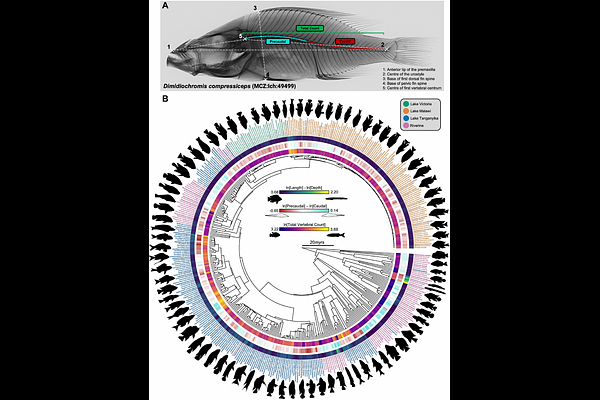African Cichlid Lake Radiations Recapitulate Riverine Axial Morphologies Through Repeated Exploration of Morphospace

African Cichlid Lake Radiations Recapitulate Riverine Axial Morphologies Through Repeated Exploration of Morphospace
Bucklow, C. V.; Ribeiro, E. D.; Ronco, F.; Vranken, N.; Oliver, M. K.; Salzburger, W.; Stiassny, M.; Benson, R.; Verd, B.
AbstractAfrican cichlids comprise more than 1800 species of freshwater fishes, with remarkable adaptive radiations in Lakes Tanganyika, Malawi, and Victoria that have given rise to extraordinary morphological diversity. However, the evolution of the cichlid axial skeleton has been largely overlooked, despite its high variation and functional significance for locomotion. Here, we present the first macroevolutionary study of axial morphology in African cichlids, based on phylogenetic comparative analyses of 4861 individuals from 583 species. Adaptation to demersal, pelagic, and piscivorous niches has led to the evolution of elongate bodies with high vertebral counts in lacustrine cichlids, emphasising the role of the fusiform body shape in ecological adaptation. However, riverine species occupy a broader axial morphospace than lacustrine species, which is partly explained by a higher stochastic rate of vertebral count evolution in riverine lineages. In addition, the occupied axial morphospace broadly correlates with the estimated age of the lacustrine radiations, suggesting that exploration of axial morphospace is a function of divergence time. However, rates of vertebral count evolution are not the same across the lake radiations. Therefore, accumulated variation in vertebral counts (and more broadly axial morphospace) is not solely a function of divergence time. Finally, we show that the common ancestor of African cichlids possessed a distinctly riverine axial morphology, indicating that the exploration of axial morphospace radiated outward from this ancestral riverine form. These findings highlight the importance of a comparative approach to studying cichlid evolution and underscore the value of African cichlids as a model for investigating the evolutionary and developmental dynamics of the teleostean vertebral column.